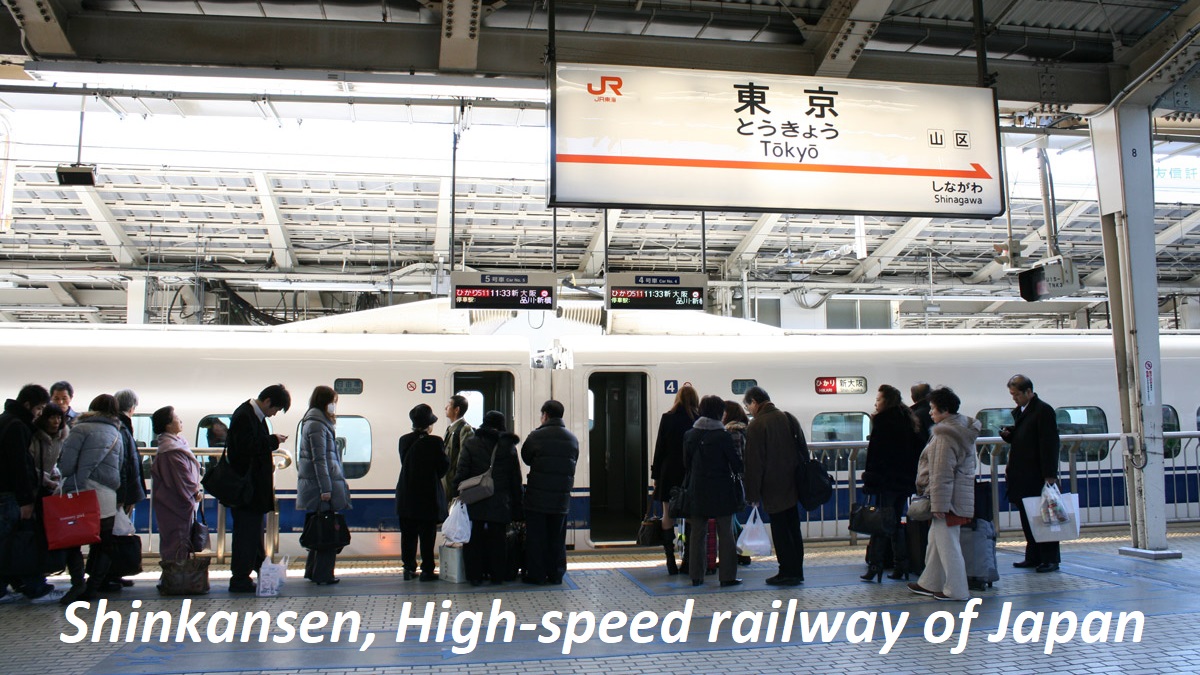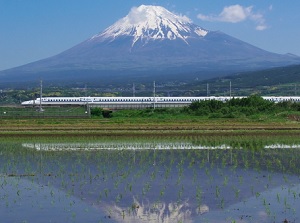Shinkansen, High-speed railway of Japan
Shinkansen (新幹線) is the high-speed railway of Japan.
It means "New trunk lines".
Most lines have the tracks for Shinkansen only and the stations are constructed only in main cities.
This is the special limited express of Japan, so many main cities are connected from Tokyo.
It is very available for your travel in Japan because it is very fast, punctual and safe.
Shinkansen from Tokyo to western Japan
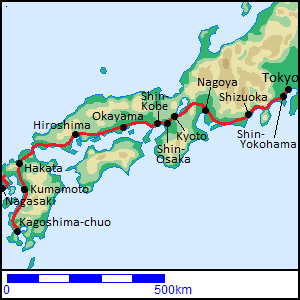
To western Japan, only one line is set up.
It connects Tokyo and many big cities and it is the most important and busy line.
The main stations are the following.
(The station name with "Shin-" is located apart from the central station.)
- Tokyo (0 km)
- Shin-Yokohama (26 km)
- Shizuoka (167 km)
- Nagoya (342 km)
- Kyoto (476 km)
- Shin-Osaka (515 km)
- Shin-Kobe (548 km)
- Okayama (676 km)
- Hiroshima (821 km)
- Hakata (1069 km)
- Kumamoto (1167 km)
- Kagoshima-chuo (1326 km)
Three sections are named according to the managing JR companies.
The names are displayed on the sign of the station.
But, you need not to distinguish them.
- Tokyo - Shin-Osaka : Tokaido Shinkansen (東海道新幹線), by JR Cenreal
- Shin-Osaka - Hakata : Sanyo Shinkansen (山陽新幹線), by JR West
- Hakata - Kagoshima-chuo : Kyushu Shinkansen (九州新幹線), by JR Kyushu
In addition, the branch line from Hakata to Nagasaki in Kyushu Island is planned and a short section (Takeo-Onsen - Nagasaki, 66 km) was partly opened in 2022.
It is Nishi-Kyushu Shinkansen (西九州新幹線), the passengers by limited express of conventional JR line transfer to the Shinkansen at Takeo-Onsen station.
The names of Shinkansen train to westhern Japan
Three types of express are operated from Tokyo.
These are operated between Tokyo and Hakata.
- Nozomi (のぞみ) : The fastest train. It stops at only major stations.
(Japan Rail Pass is not available.) - Hikari (ひかり) : The second fastest train. It stops at some main stations.
- Kodama (こだま) : It stops at all stations of Shinkansen line.
Between Tokyo and Shin-Osaka, very many trains run.
5 to 7 Nozomi, 2 Hikari, 2 Kodama start at Tokyo every hour.
So the trains run every some minutes like commuter train.
By the fastest Nozomi, from Tokyo, it takes 1 hour 35 minutes to Nagoya, 2 hours 10 minutes to Kyoto, 2 hours 25 minutes to Shin-Osaka.
Toward the west of Shin-Osaka, three types of express for Kyushu Island are added.
- Mizuho (みずほ) : The fastest train. It stops at only major stations.
(Japan Rail Pass is not available.) - Sakura (さくら) : The second fastest train. It stops at some main stations.
- Tsubame (つばめ) : It stops at all stations of Shinkansen from Hakata.
Shinkansen from Tokyo to northern Japan
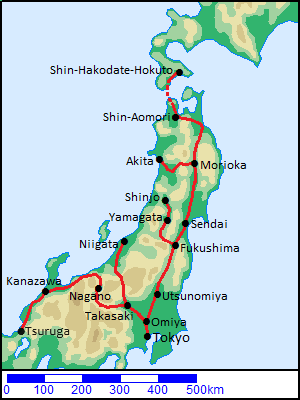
To northern Japan, some branch lines are set up.
It connects Tokyo and many local cities in the wide area.
Each line also has a name.
The main stations are the following.
(The station name with "Shin-" is located apart from the central station.)
Tohoku Shinkansen (東北新幹線, Tokyo - Shin-Aomori) & Hokkaido Shinkansen (北海道新幹線, Shin-Aomori - Shin-Hakodate-Hokuto)
The line passes through Seikan undersea tunnel (53.8 km) between Honshu and Hokkaido islands.
- Tokyo (0 km)
- Omiya (31 km)
- Utsunomiya (109 km)
- Fukushima (255 km)
- Sendai (325 km)
- Morioka (497 km)
- Shin-Aomori (675 km)
- Shin-Hakodate-Hokuto (824 km)
Yamagata Shinkansen (山形新幹線, Tokyo - Fukushima - Shinjo)
- Tokyo (0 km)
- Omiya (31 km)
- Utsunomiya (109 km)
- Fukushima (255 km)
- Yamagata (342 km)
- Shinjo (404 km)
Akita Shinkansen (秋田新幹線, Tokyo - Morioka - Akita)
- Tokyo (0 km)
- Omiya (31 km)
- Utsunomiya (109 km)
- Fukushima (255 km)
- Sendai (325 km)
- Morioka (497 km)
- Akita (624 km)
Joetsu Shinkansen (上越新幹線, Tokyo - Niigata)
- Tokyo (0 km)
- Omiya (31 km)
- Takasaki (109 km)
- Nagaoka (245 km)
- Niigata (301 km)
Hokuriku Shinkansen (北陸新幹線, Tokyo - Tsuruga)
- Tokyo (0 km)
- Omiya (31 km)
- Takasaki (109 km)
- Nagano (226 km)
- Toyama (396 km)
- Kanazawa (454 km)
- Fukui (530 km)
- Tsuruga (579 km)
Tohoku, Yamagata, Akita, Joetsu Shinkansens are managed by JR East company.
Hokkaido Shinkansen is managed by JR Hokkaido company.
Hokuriku Shinkansen is managed by both JR East and West companies.
But, you need not to distinguish them.
The names of Shinkansen train to northern Japan
From Tokyo station, various trains for above all lines start.
Because a few trains to each line are operated every hour, the trains for various destinetions start every some minutes.
In some trains, two trains for different destination are connected.
They are divided at a branch station. (Fukushima or Morioka)
Each train has the name for the line.
The passengers must get on the right train after checking the name of train.
Tohoku & Hokkaido Shinkansen
- Hayabusa (はやぶさ) : The fastest train. It stops at only major stations.
- Yamabiko (やまびこ) : The second fastest train. It stops at some main stations.
- Nasuno (なすの) : It stops at all stations of Shinkansen line.
- Hayate (はやて) : It stops at all stations of Shinkansen line from Morioka.
Yamagata, Akita, & Joetsu Shinkansen
- Tsubasa (つばさ) : The train for Yamagata Shinkansen.
- Komachi (こまち) : The train for Akita Shinkansen.
- Toki (とき) : The train for Joetsu Shinkansen.
- Tanigawa (たにがわ) : It stops at all stations of Joetsu Shinkansen.
Hokuriku Shinkansen
- Kagayaki (かがやき) : The fastest train. It stops at only major stations.
- Hakutaka (はくたか) : The second fastest train. It stops at some main stations.
- Asama (あさま) : It stops at all stations of Hokuriku Shinkansen.
- Tsurugi (つるぎ) : The train between Toyama and Tsuruga.
How to buy Shinkansen ticket
All Shinkansen trains are operated by JR companies.
JR companies are originally the Japan National Railway, and have the nationwide railway network.
Because Shinkansen is a limited express of JR, you can use Shinkansen by JR ticket.
When you transfer from Shinkansen to a JR line, you can pass the transfer gate by the ticket.
You can buy the ticket at any JR station.
A Shinkansen train have some "Reserved Seat Cars", a few "Non-Reserved Seat Cars" and a few "Green Cars".
The faster train has more Reserved Seat Cars and less Non-Reserved Seat Cars.
When you want to get your seat surely, buy the reserved seat ticket.
In non-reserved seat car, you can sit on your favorite seat.
But when the car is crowded, you may be forced to stand until any seats is open.
The fare is a little cheaper than reserved seat.
Green Car is like first class of airplane.
The seat of Green Car of Shinkansen is reserved but the fare is more expensive than the other reserved seat.
If you use Japan Rail Pass, you can board a Shinkansen train.
But, you can't use "Nozomi" and "Mizuho" by the pass.
When you get on Reserved Seat Car or Green Car in a train, you must get the "Reserved‐seat ticket" after showing Japan Rail Pass at a station in advance.
No sleeping car and dining car
Shinkansen is operated from 6:00 to 24:00.
So, it has no sleeping car.
And, Shinkansen has no dining car.
Therefore, when you must stay in the car at mealtime, it is a way that you buy a box lunch and enjoy it in the car.
You can see Mt.Fuji in Tokaido-Shinkansen in winter
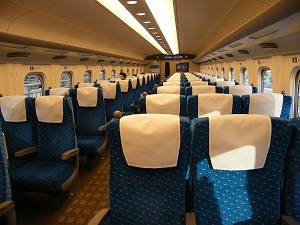
Seats of Shinkansen, Photo by Railstation.net
You can see Mt.Fuji when it is fine and the air is clean in winter.
After about 40 to 50 minutes from Tokyo by Shinkansen Nozomi, you can see the mountain on the right hand.
In the Shinkansen car, 3-seats and 2-seats are installed on both sides.
"A","B","C" are assigned to the 3-seats side and "D","E" are assigned to the 2-seats side.
And the seat that you can see Mt.Fuji directly is "E" (window seat) of 2-seat. (Of course, you can see it on the other seat.)
When you buy the reaserved-seat ticket, you can request "E" seat.
Short History of Shinkansen
After Japan was defeated in the World War II (1945), the engineers of the Japan National Railway planned a high-speed railway because the main lines of railway almost reached their limits of transportation capacity.
Railway had already been a declining industry, but the Japanese government approved the construction project of Shinkansen in 1958.
Though they overcame many difficulties, the engineers developed with the technologies which had been accumulated for a long time.
At last, just before the Tokyo Olympic Game in 1964, the first Shinkansen opened between Tokyo and Shin-Osaka on October 1st. (The opening day of the Olympic was October 10th.)
The realization of the train running at a speed of 200 km/h surprised the world.
Since then, new routes have been constructed.
Shinkansen has changed completely the transportation by railway in Japan.
Over half century have passed since the start of Shinkansen.
But, no fatal passenger accident has occurred.
Only three times, Shinkansen ran off the track by great earthquakes (2004 Niigata, 2016 Kumamoto and 2022 Tohoku).
But the passengers were safe.
Even when the Great East Japan Earthquake occurred in 2011, all Shinkansen trains stopped automatically and safely.
Now, the new high-speed train system "Maglev" has been devloped and the route between Tokyo and Nagoya is under construction.
The Japanese name is "Linear Chuo Shinkansen" and it will complete around 2034.
The max speed is 500 km/h and it will run only in 40 minutes between Tokyo and Nagoya about 285 km long.

